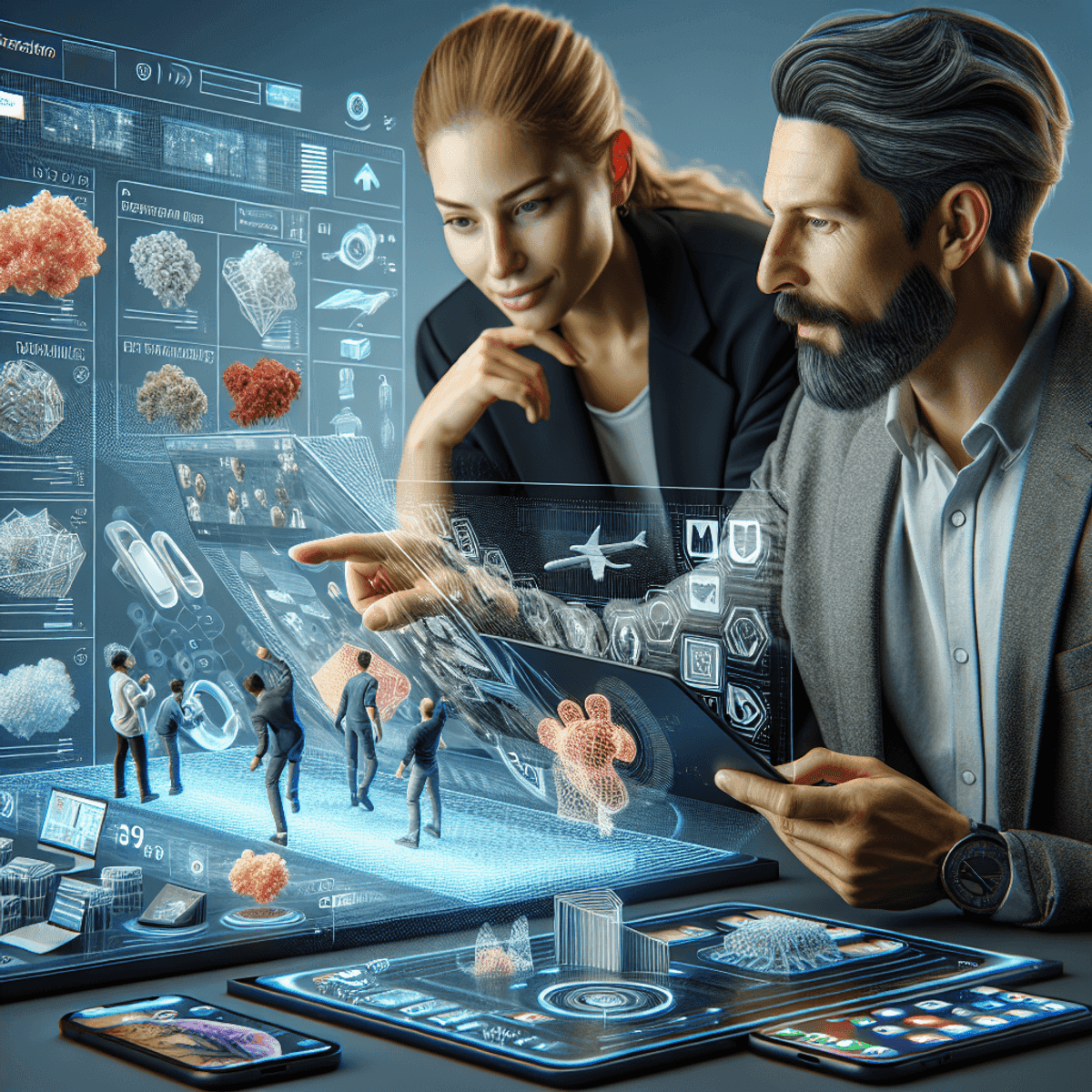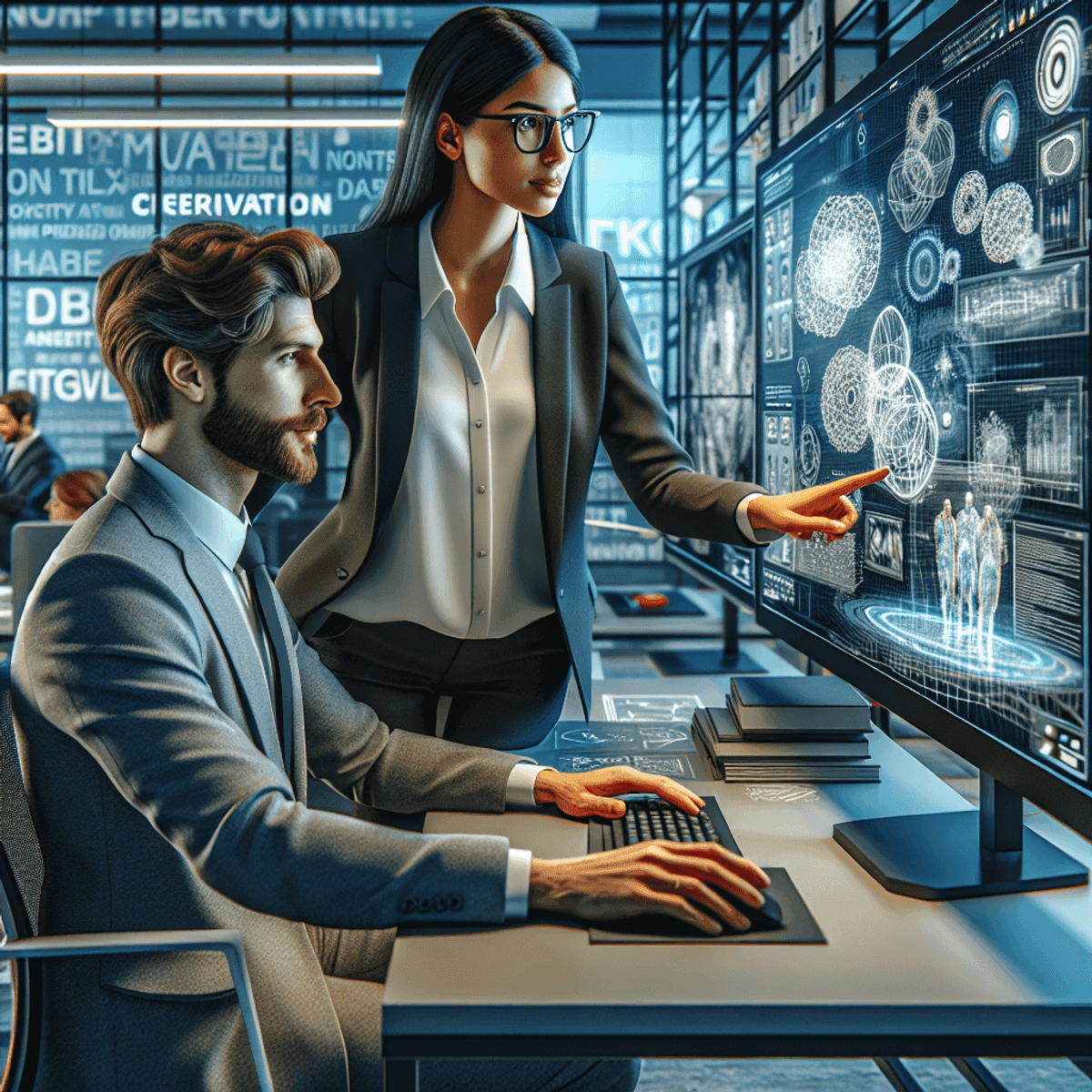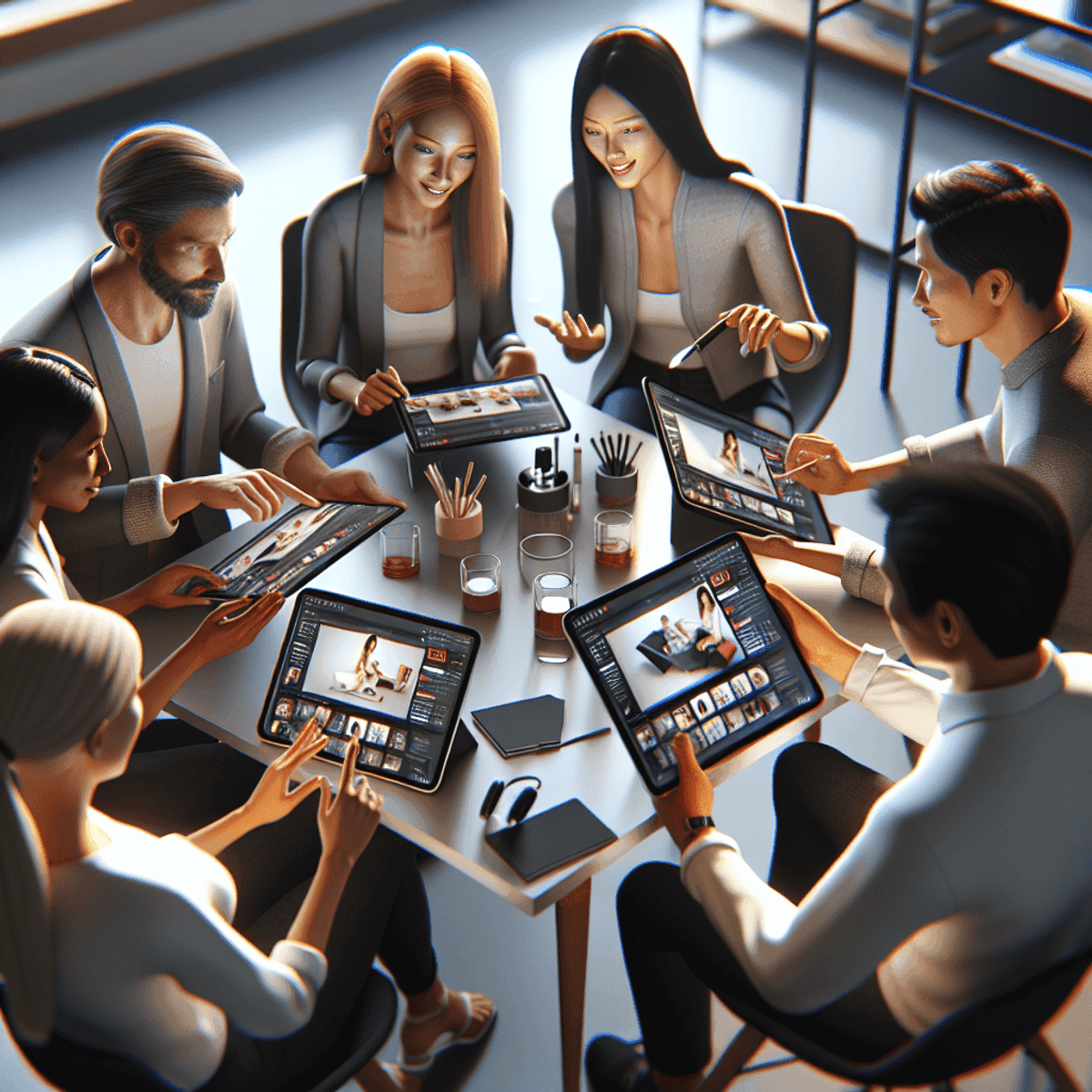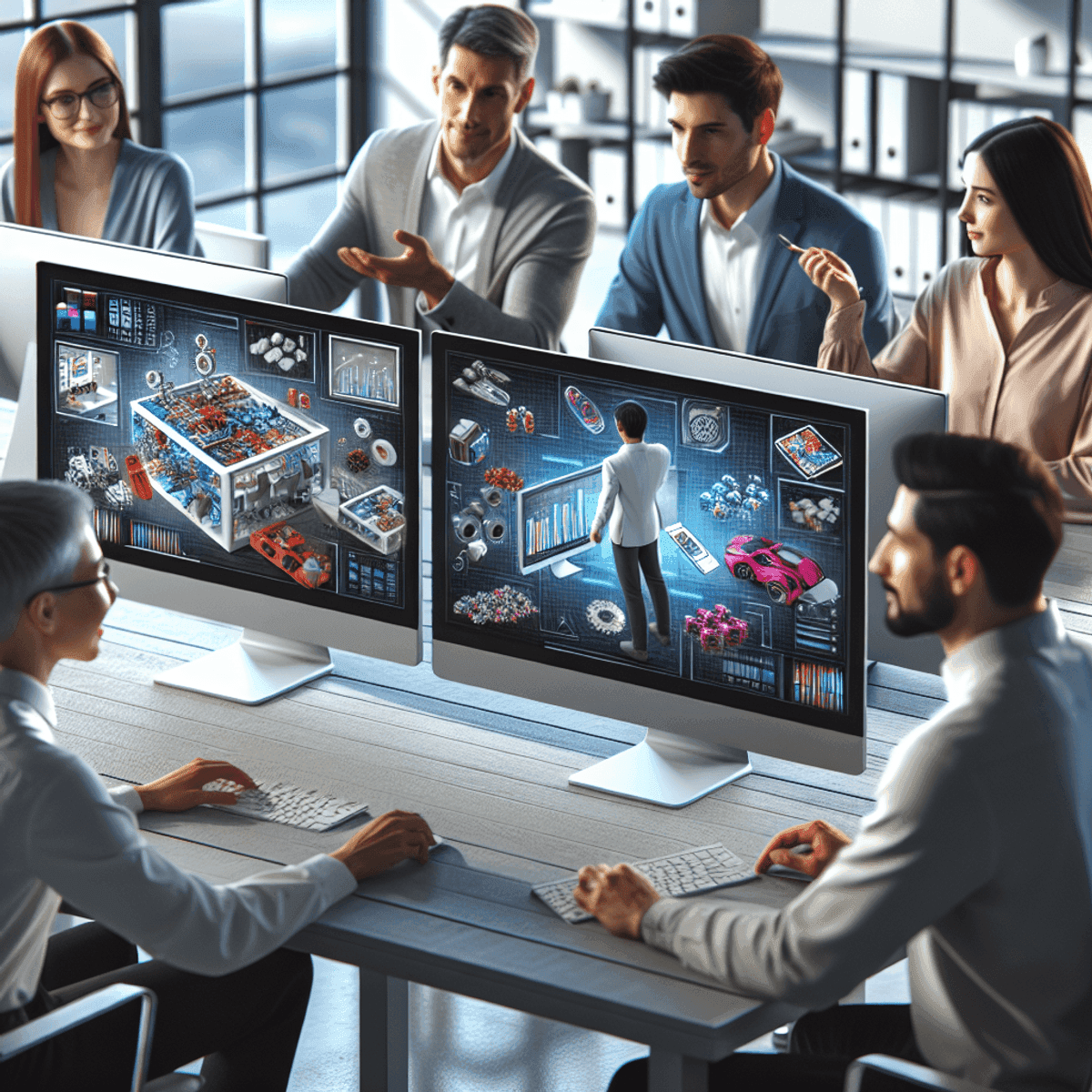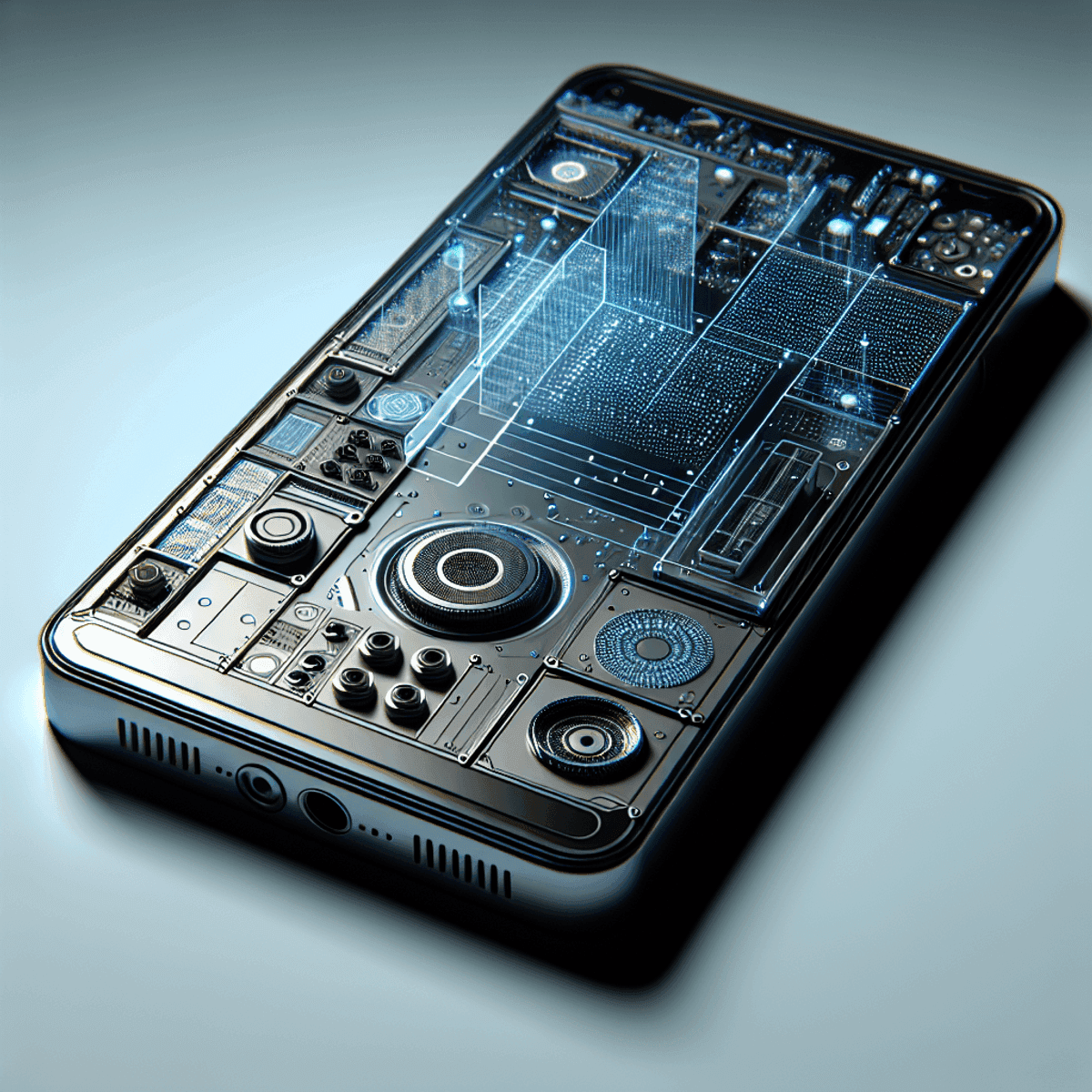Introduction
The world of online shopping is constantly changing, and one technology that is making a big difference is 3D product visualization. This innovative tool allows e-commerce businesses to showcase their products in stunning detail, creating an engaging shopping experience for customers.
While traditional product photography has its merits, it often fails to capture every intricate detail of a product. That's where 3D rendering comes in, offering a level of precision and interactivity that static images simply can't provide.
Why Visual Content Matters in E-Commerce
When it comes to online shopping, high-quality visuals are crucial. They not only attract attention but also have a significant impact on sales and customer satisfaction. Studies show that customers are more likely to make informed purchasing decisions when they can see products from different angles and fully understand their features. This leads to fewer returns and increased confidence in their buying choices.
What You Will Learn in This Guide
In this guide, we will explore the world of 3D product visualization and its importance in e-commerce. Here's what you can expect to learn:
The basics of 3D product rendering and why it matters for online businesses.
How traditional photography compares to 3D rendering.
The ways in which advanced 3D visuals can help customers make better decisions.
The advantages of adding interactive elements like augmented reality (AR) and 360-degree views.
Examples of brands successfully using these technologies to boost sales.
Operational benefits such as quicker product launches and cost savings.
Applications in different industries and future trends shaping e-commerce.
By understanding these topics, you'll be able to leverage the power of 3D product visualization to enhance your online retail strategy and achieve tangible results.
Understanding 3D Product Rendering
Definition of 3D Product Rendering
3D product rendering refers to the process of creating three-dimensional digital representations of products. These visualizations are photorealistic, enabling customers to view and interact with products in a highly detailed and engaging manner. In e-commerce, 3D Product Rendering Services play a crucial role by providing detailed visuals that significantly enhance the online shopping experience.
Differences Between 3D Rendering and Traditional Product Photography
While traditional product photography captures real-life images of products using cameras and lighting, Product Rendering uses advanced software to create digital models. Here are key differences:
Flexibility: Adjusting angles, lighting, or colors in 3D renders is straightforward without needing physical reshoots.
Consistency: Ensures uniformity across different product lines and marketing materials.
Cost-effectiveness: Eliminates the need for physical prototypes and extensive photoshoots.
Interactivity: Allows for features like 360-degree views or augmented reality (AR) experiences.
The Technology Behind Photorealistic Renders
Creating photorealistic renders involves sophisticated techniques and software applications. The process includes:
Modeling: Artists create detailed 3D models based on product designs.
Texturing: Applying materials and textures to mimic real-world surfaces.
Lighting: Simulating natural or artificial light sources to enhance realism.
Rendering: Using powerful algorithms to generate high-resolution images.
VFX Compositing Techniques: Integrating visual effects for added realism, such as reflections, shadows, and depth of field.
The Evolution of Product Visualization
Historical Context: From Traditional Photography to Advanced 3D Renders
Initially, e-commerce relied heavily on traditional photography for product visualization. This method had limitations in terms of flexibility and scalability. With the advent of digital technology:
Early Digital Imaging: Basic digital photography offered some improvements but was still limited by physical constraints.
Introduction of CAD Models: Computer-Aided Design (CAD) models allowed more accurate digital representations but lacked photorealism.
Technological Advancements Transforming Visualization
Technological advancements have significantly impacted how products are visualized online:
High-Performance Graphics Processing Units (GPUs): Enabled faster rendering times and increased detail levels.
Advanced Software Tools: Programs like Blender, Maya, and Cinema 4D provide robust tools for detailed modeling and rendering.
Machine Learning & AI: Enhancing texture application, lighting adjustments, and automating repetitive tasks.
Interactive Technologies: Integration with AR/VR platforms enables immersive shopping experiences.
These advancements have revolutionized digital product visualization, making it an indispensable tool in modern e-commerce strategies.
By understanding the nuances and technological foundations of 3D product rendering, businesses can leverage these innovations to deliver superior customer experiences and drive sales growth through enhanced visual content.
Benefits of Using 3D Product Visualization in E-Commerce
Enhanced Visualization and Customer Confidence
Detailed 3D renders offer a level of precision and clarity that traditional photos often fail to match. These high-fidelity visuals provide customers with a comprehensive view of the product, capturing intricate details such as textures, materials, and color variations. This enhanced visualization is crucial for online shoppers who rely solely on images to make purchase decisions.
Accuracy: 3D renders eliminate discrepancies that may arise from inconsistent lighting or angles in traditional photography.
Customization: Customers can view products in various configurations and settings, helping them visualize how the product fits into their personal environment.
Building Customer Trust Through Accurate Representation
Accurate and detailed product representation plays a pivotal role in building customer trust. When consumers feel confident that what they see online will match what arrives at their doorstep, they are more likely to complete a purchase. This trustworthiness stems from:
Consistency: Uniformity across all product images ensures customers know exactly what to expect.
Transparency: Detailed visuals reduce the likelihood of misunderstandings or unmet expectations.
Impact on Customer Satisfaction Levels
Customer satisfaction is significantly influenced by the quality of visual content. High-quality 3D renders contribute to:
Reduced Returns: Clear and accurate visuals help customers make more informed decisions, reducing the chances of dissatisfaction upon receiving the product.
Increased Loyalty: Satisfied customers are more likely to return for future purchases, fostering brand loyalty.
Improving Customer Decision-Making with 3D Visuals
Influence on Buying Behavior
3D visuals have a profound impact on customer decision-making. They provide an immersive experience that allows customers to interact with the product in ways static images cannot. This interactive element can include features such as zooming in on specific parts or rotating the product for a full 360-degree view.
"Seeing is believing." This adage holds especially true in e-commerce, where visual impact directly affects buying behavior.
Providing Clearer Understanding
The role of 3D rendering extends beyond merely showcasing a product; it aids in providing a clearer understanding of its functionalities and benefits.
Interactive Exploration: Allows users to explore every aspect of the product before making a decision.
Contextual Presentation: Demonstrates how the product can be used in real-life scenarios, enhancing its appeal.
Reducing Return Rates Through Improved Visualization
One of the significant advantages of detailed 3D renders is their potential to reduce return rates. Accurate visual representation ensures that customers have realistic expectations of the product, which leads to:
Lower Return Costs: Fewer returns mean reduced logistical expenses for businesses.
Enhanced Customer Experience: A smooth buying process without the hassle of returns enhances overall customer satisfaction.
Leveraging Visual Impact on Buying Behavior
The visual impact of 3D renders goes beyond aesthetics; it actively influences purchasing decisions. By presenting products in an engaging and informative manner, businesses can:
Increase Conversion Rates: Better visuals lead to higher engagement levels, which translates into increased sales.
Encourage Impulse Buys: Detailed and attractive renders can captivate customers' attention, prompting them to make quicker purchase decisions.
Seamless integration between these aspects ensures that each element supports and enhances the others, creating a cohesive strategy that maximizes the benefits of 3D product visualization in e-commerce.
Creating Interactive Experiences with 3D Product Visuals
Role of AR Technology in Enhancing Product Exploration
Augmented reality (AR) technology is transforming the online shopping experience by allowing customers to see products in their real-world environment. This immersive experience brings together physical stores and e-commerce, giving customers a better understanding of the product without having to leave their homes.
Key Advantages of AR in E-Commerce:
Enhanced Visual Understanding: Customers can see how a product fits within their space or complements their existing items, crucial for industries like furniture and home decor.
Increased Confidence: The ability to interact with a product virtually leads to higher customer confidence, reducing return rates and boosting satisfaction.
Personalized Shopping Experience: Customization features enable users to modify product colors, sizes, and configurations, providing a tailored shopping journey.
How Interactive Features Engage Users
Interactive features such as clickable hotspots, zoom functionalities, and configurators deepen user engagement. These elements allow potential buyers to explore products in greater detail and customize options to meet their preferences.
Engaging Interactive Features:
Clickable Hotspots: Highlight specific product features or benefits, offering detailed information upon interaction.
Zoom Functionalities: Enable customers to view intricate details such as textures or craftsmanship up close.
Configurators: Allow users to personalize products by changing colors, materials, or other attributes in real-time.
These interactive elements make users feel more connected to the items they are viewing, fostering a deeper emotional connection that can drive purchasing decisions.
The Future of AR in E-Commerce
The future of AR in e-commerce looks promising with continuous advancements in technology. As AR becomes more accessible through smartphones and wearable devices, its integration into online shopping platforms will become increasingly seamless. Future trends may include:
Enhanced Realism: Improved graphic capabilities will render even more lifelike visuals.
Wider Adoption: More sectors beyond fashion and furniture will leverage AR for customer engagement.
AI Integration: AI could further personalize the AR experience by suggesting products based on user behavior and preferences.
The Power of 360-Degree Product Views
Offering 360-degree views of products is another powerful tool for enhancing the online shopping experience. This feature allows customers to rotate products and examine them from every angle, providing a comprehensive understanding of what they are buying.
Benefits of 360-Degree Product Views:
Improved Visualization: Customers gain a complete perspective of the product's design and functionality.
Higher Engagement Levels: Interactive viewing keeps users on the website longer and increases their likelihood of purchase.
Decreased Return Rates: Better visual information leads to more informed buying decisions, reducing returns due to unmet expectations.
Case Studies: Successful Implementations
Several brands have successfully utilized 360-degree views to boost engagement:
IKEA: Their use of 360-degree views for furniture has significantly improved customer interaction on their website, driving higher conversion rates.
Nike: By implementing 360-degree views for footwear, Nike provides a detailed look at product craftsmanship that standard photos can't capture.
These examples highlight how integrating immersive visual technologies like AR and 360-degree views can substantially enhance user experience and drive business growth.
Driving Sales and Conversions through Effective Use of 3D Visuals
Conversion rates and boosting sales are critical metrics in e-commerce, and 3D product rendering can be a game-changer in this context. Data consistently shows a positive correlation between the use of 3D visuals on e-commerce websites and increased conversion rates.
Impact on Conversion Rates
Statistics: According to a study by Shopify, products that incorporate 3D or AR experiences have seen up to a 250% increase in conversion rates.
Customer Engagement: Enhanced engagement through interactive 3D visuals keeps potential buyers on the site longer, increasing the likelihood of purchase.
Reduced Return Rates: Accurate, detailed renders help customers make informed decisions, leading to fewer returns.
Case Studies: IKEA and Amazon
IKEA has been a frontrunner in utilizing 3D product rendering to drive sales:
"IKEA's AR app allows customers to visualize furniture in their own spaces, resulting in a significant boost in online sales and reduced return rates."
Amazon also leverages 3D visuals for its product listings. High-definition 360-degree views provide customers with comprehensive perspectives, directly impacting purchasing decisions.
Leveraging 3D Visuals for Upselling and Cross-Selling
3D product visuals are not only effective for primary product sales but also serve as powerful tools for upselling and cross-selling.
Promoting Related Products
Interactive Features:
Customers can explore complementary items through interactive hotspots within the 3D model.
For instance, clicking on a dining table might reveal matching chairs or tableware sets.
Bundling Options:
Display bundles or sets as part of the 3D experience. This approach encourages customers to consider purchasing multiple related items together.
Encouraging Larger Purchases
Detailed Visualization:
High-quality renders showcase premium features more effectively than flat images, justifying higher price points for luxury items.
Customization Options:
Allowing customers to customize products in real-time (e.g., changing colors or materials) leads to higher satisfaction and willingness to pay extra for personalized options.
Strategies for Increasing Online Conversions with 3D Renders
Enhanced Product Pages:
Incorporate dynamic 3D models that allow users to interact with the product from all angles.
Virtual Try-Ons:
Especially effective in fashion and accessories; AR technology enables customers to virtually try on products before purchasing.
Storytelling Through Animation:
Use animated sequences to demonstrate product features or assembly processes, making it easier for customers to understand complex items.
The integration of these strategies establishes a compelling case for adopting 3D Product Rendering in E-Commerce, significantly influencing customer behavior and driving measurable results.
Operational Advantages Offered by Implementing 3D Product Rendering Strategies
Benefits of Faster Product Launches with Virtual Prototyping
Implementing virtual prototyping methods within a 3D rendering workflow can significantly accelerate product launches. Time-to-market benefits are critical in the fast-paced world of e-commerce, where being first can often translate into capturing a larger market share.
Rapid Iteration: Virtual prototypes allow for quick adjustments without the need for physical samples.
Immediate Feedback: Design teams can gather instant feedback and make necessary modifications on the fly, ensuring that products meet market demands swiftly.
Cost-Effectiveness Compared to Traditional Photography
Traditional photography techniques often involve high costs related to setting up physical shoots, hiring photographers, and post-processing. With 3D rendering, businesses can achieve comparable or even superior quality at a fraction of the cost.
Reduced Overheads: Eliminate expenses linked to studio rentals, equipment, and photography teams.
Reusability: Once created, 3D models can be reused across various marketing channels without incurring additional costs.
Scalability for Large Marketing Campaigns
The scalability of 3D rendering is unmatched when compared to traditional methods. This scalability is particularly beneficial for extensive marketing campaigns that require consistent visual content across multiple platforms.
Uniformity: Ensure that all visuals maintain a consistent look and feel, essential for brand identity.
Volume Production: Quickly generate multiple variations of product visuals tailored to different audiences or regions.
Streamlining Product Development with 3D Rendering
Accelerating the Product Development Process
3D rendering plays a pivotal role in streamlining product development. By creating detailed virtual models early in the design phase, companies can identify potential issues before they arise in physical prototypes.
Enhanced Visualization: Detailed renders provide a clear view of the final product, allowing stakeholders to make informed decisions during the development process.
Collaboration: Teams across different geographies can collaborate seamlessly using shared 3D models.
Reducing Time-to-Market with Virtual Prototypes
Virtual prototypes drastically reduce time-to-market by eliminating many stages associated with traditional prototyping.
"The ability to visualize and iterate designs virtually allows us to move from concept to launch in record time," says Jane Doe, Head of Product Development at Jobe Graphic.
Efficiency Gains: Virtual models enable faster testing and validation cycles.
Market Responsiveness: Swiftly adapt to market trends and consumer feedback without lengthy delays.
By harnessing these operational advantages, businesses not only save time and money but also enhance their ability to respond dynamically to market demands. Implementing 3D product rendering strategies offers a competitive edge by facilitating faster launches, reducing costs, and scaling efficiently—all crucial elements for success in today's e-commerce landscape.
Exploring Applications Across Different Industries for Enhanced Online Shopping Experiences with 3D Visuals
Industries Benefiting from Immersive Experiences
Numerous industries are leveraging high-quality 3D renders to mitigate common challenges in online transactions. Two sectors that have seen significant benefits include furniture and fashion.
Furniture Industry
Product Customization: 3D visualization allows customers to see how different configurations of a piece will look in their space.
Enhanced Details: High-resolution renders provide a close-up view of fabric textures and fine craftsmanship, aspects often missed in traditional photography.
Fashion Industry
Virtual Try-Ons: Augmented reality (AR) enables virtual fitting rooms, allowing customers to see how clothes will fit and look on them.
Material Representation: Detailed 3D renders showcase the quality of fabrics and intricate design elements, helping customers make informed decisions.
Sector-Specific 3D Applications
Other sectors are also embracing the potential of 3D rendering to address unique online shopping challenges.
Automotive Industry
Interactive Configurators: Customers can customize vehicles by changing colors, wheels, interiors, and more in real-time.
Virtual Test Drives: Prospective buyers can experience a virtual test drive, enhancing their decision-making process.
Consumer Electronics
Exploded Views: Detailed 3D models display the internal components of devices, highlighting features and build quality.
Interactive Manuals: 3D renders are used in interactive user manuals to guide customers through setup and troubleshooting.
Case Studies: Success Stories from Various Industries
IKEA: Transforming Furniture Shopping
IKEA has implemented 3D visualization extensively. Their AR app allows users to place true-to-scale 3D models of furniture in their homes. This capability has reduced returns and increased customer satisfaction by giving buyers confidence that their choices will fit well within their spaces.
Nike: Revolutionizing Fashion with VR
Nike leverages VR for virtual shoe try-ons. Customers can visualize how different shoes look on their feet through a smartphone app, leading to higher conversion rates and fewer returns.
Tesla: Innovating Automotive Sales
Tesla’s online configurator is an exemplary case of using 3D rendering effectively. Customers can personalize every aspect of their vehicle on the website, from paint color to interior finishes. This interactive experience has driven engagement and facilitated smoother purchasing processes.
Quantifiable Results Achieved through 3D Visualization
The impact of integrating 3D visualization into e-commerce strategies is measurable:
Increased Conversion Rates: Brands like IKEA have reported significant boosts in conversion rates due to immersive shopping experiences.
Reduced Return Rates: Accurate representations of products through high-quality renders have led to fewer return requests.
Enhanced Customer Engagement: Interactive features keep customers engaged longer, increasing the likelihood of completing purchases.
These examples underscore the transformative potential of 3D visualization across various industries, demonstrating its role in enhancing customer experiences and driving tangible business outcomes.
Future Trends Shaping the Landscape of E-Commerce Through Innovative Approaches like VR/AI Integration
Potential Advancements on the Horizon
Emerging technologies like virtual reality (VR) and artificial intelligence (AI) promise to redefine the e-commerce landscape. These advancements hold significant potential for enhancing user experiences delivered via 3D rendering solutions.
VR in E-Commerce:
Immersive Shopping Experiences: Virtual reality can transport customers into a fully immersive shopping environment, allowing them to interact with products in a more engaging manner. Imagine walking through a virtual store, examining products as if they were physically present.
Enhanced Product Interaction: By leveraging VR, customers can explore product features in-depth, understanding size, texture, and functionality without leaving their homes.
AI in 3D Rendering:
Personalized Shopping: AI can analyze customer behavior and preferences to create tailored shopping experiences. This personalization can lead to higher customer satisfaction and increased conversion rates.
Predictive Analytics: AI algorithms can predict trends and suggest products that align with customer needs, driving more informed purchasing decisions.
The Role of AI in Automating 3D Rendering Processes
Artificial intelligence is not only transforming how products are presented but also revolutionizing the workflows behind 3D rendering.
How AI is Transforming 3D Rendering Workflows:
Automated Modeling: AI-driven tools can generate detailed 3D models from simple sketches or photographs, significantly reducing the time and effort required by human artists.
Smart Texturing: By analyzing existing textures, AI can apply realistic materials to 3D models automatically, ensuring consistency and quality across all visual content.
Potential for Automation:
Cost Reduction: Automation through AI minimizes manual labor costs associated with traditional rendering techniques. Businesses can achieve high-quality visuals at a fraction of the cost.
Increased Efficiency: Automated processes streamline workflows, allowing faster turnaround times for product visualizations. This efficiency is crucial for e-commerce businesses needing to keep up with rapid market changes.
By integrating cutting-edge technologies like VR and AI into e-commerce strategies, businesses can offer unparalleled shopping experiences while optimizing their operational workflows. These innovations not only enhance user engagement but also drive efficiency and cost-effectiveness in product visualization efforts.
Choosing a Reliable Provider for Your Business Needs in This Space
Selecting a suitable service option for 3D product rendering in e-commerce requires careful consideration. The right provider can significantly impact your business's visual presentation, influencing customer engagement and sales.
Key Factors to Consider
Experience and Portfolio: Evaluate the provider's experience in the industry. A robust portfolio showcasing diverse projects can give you insights into their expertise and creativity. Look for examples relevant to your sector to gauge their capability.
Technology and Tools: Ensure the provider uses cutting-edge technology and software to create high-quality renders. Advanced tools enable the creation of hyper-realistic visuals that can make your products stand out.
Customization Options: The ability to customize renders according to specific needs is crucial. Check if the provider offers tailored solutions that align with your brand's aesthetic and functional requirements.
Turnaround Time: Time efficiency is vital in e-commerce. Inquire about the provider’s turnaround times to ensure they can meet your deadlines without compromising on quality.
Questions to Ask Potential Partners
What is your experience in 3D product rendering for e-commerce?
Can you provide examples of similar projects you've completed?
What software and technologies do you use?
How do you handle customization requests?
What are your typical turnaround times?
Can you share client testimonials or case studies?
These questions help establish a clear understanding of the provider's capabilities and reliability.
How to Assess Quality and Reliability
Assessing the quality of 3D rendering services involves several steps:
Reviewing Portfolios: Examine their previous work for detail, realism, and consistency.
Client Feedback: Seek reviews or testimonials from existing clients to understand their satisfaction levels.
Sample Renders: Request sample renders of your products to evaluate their quality firsthand.
Technical Proficiency: Verify their technical skills by discussing their processes and tools used.
Comparing Costs and Value Among 3D Rendering Providers
Navigating 3D rendering costs requires a balanced approach, ensuring you get value for money without compromising on quality.
Cost Comparison Tips
Obtain Multiple Quotes: Request quotes from several providers to compare pricing structures.
Understand Pricing Models: Some providers offer flat rates while others charge per project or hour. Understand these models to determine which suits your budget best.
Inclusions in Pricing: Clarify what is included in the price—such as revisions, different viewing angles, or interactive features—to avoid hidden costs later.
Evaluating the Balance Between Cost and Quality
Balancing cost with quality means considering:
Return on Investment (ROI): Higher-quality renders might have a higher upfront cost but can lead to better customer engagement and higher sales conversion rates.
Long-term Relationships: Investing in a reliable provider can ensure consistent quality over time, leading to long-term benefits.
Scalability: Choose a provider who can scale their services as your business grows, ensuring continuous support without needing frequent changes.
By carefully evaluating these factors, businesses can select a reliable 3D rendering provider that meets their specific needs while offering excellent value for money.
Conclusion
The integration of 3D product rendering in e-commerce offers numerous benefits, transforming how businesses present their products online.
Key advantages include:
Enhanced Visual Appeal: Detailed 3D renders provide hyper-realistic visuals that surpass traditional photography.
Improved Customer Satisfaction: Accurate representations reduce return rates and boost customer confidence.
Interactive Shopping Experience: Features like AR and 360-degree views engage users, enriching the online shopping journey.
Increased Conversion Rates: Businesses observe higher sales and conversions by showcasing products more effectively.
Businesses aiming for e-commerce success should explore 3D rendering solutions to elevate their online presence and meet modern consumer expectations.
How does 3D rendering differ from traditional product photography?
Unlike traditional product photography, which captures a static image of a product, 3D rendering allows for dynamic and interactive visuals. It offers the ability to showcase products from multiple angles and in various settings without the need for physical samples. This flexibility enhances customer engagement and provides a clearer understanding of the product.
How can businesses choose a reliable provider for 3D rendering services?
When selecting a provider for 3D rendering services, businesses should consider factors such as the provider's portfolio quality, experience in the industry, customer reviews, and pricing structure. It's also important to ask specific questions that assess their capability to meet your e-commerce needs effectively.
What role does augmented reality (AR) play in 3D product visualization?
Augmented reality (AR) enhances the online shopping experience by allowing customers to visualize products in their own environment before making a purchase. AR technology facilitates interactive experiences such as 360-degree views and immersive displays, helping customers feel more connected to the products they are considering.
What is 3D product rendering and how does it benefit e-commerce?
3D product rendering is the process of creating photorealistic visual representations of products through digital technology. It benefits e-commerce by enhancing product visualization, which can lead to improved customer confidence, reduced return rates, and increased sales. By providing a detailed view of products, customers can make more informed purchasing decisions.
What are some operational advantages of implementing 3D product rendering strategies?
Implementing 3D product rendering strategies can lead to significant operational advantages including faster time-to-market through virtual prototyping, cost-effectiveness compared to traditional photography, and scalability for large marketing campaigns. These benefits streamline the product development process and improve overall efficiency.
by
Ayham Ayoub
Last updated


